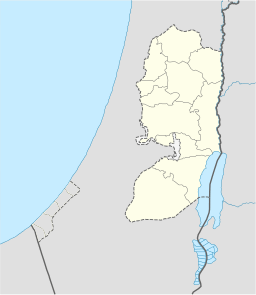Eshtemoa synagogue
The Eshtemoa Synagogue, located 15 km south of Hebron in as-Samu, West Bank, refers to the remains of an ancient Jewish synagogue dating from around the 4th–5th century CE.
 Eshtemoa ruins, 1975 | |
 Shown within the West Bank | |
| Location | |
|---|---|
| Coordinates | 31.400792°N 35.067075°E |
| History | |
| Founded | 4th–5th century CE |
| Site notes | |
| Excavation dates | 1934, 1969-70. |
History

Eshtemoa, identified as modern as-Samu, was an ancient city named in the Bible (Joshua 21:14). During Roman and Byzantine period, Eshtemoa was described as a large Jewish village.[1]
The Jerusalem Talmud (Nedarim 6:10 - Leiden Ms.) recalls a man who lived there, named Ḥasa of Eshtemoa.
The remains of the synagogue were identified by L. A. Mayer and A. Reifenberg in 1934,[2] in which site they describe a recess in the wall, once used as a Torah Ark ("Heikhal").[3][4] In 1969–70, a full excavation of the site revealed that the building occupied the most prominent site in the village. It was built in "broadhouse" style without columns and measured 13.3 m (44 ft) by 21.3 m (70 ft).[5] Entry was by any of three doors along its eastern side and one of the three niches recessed into the northern wall functioned as the Torah Ark. The building housed a mosaic floor and displayed external ornamental carvings.[1] Four seven-branched menorahs were discovered carved onto door lintels and one of them is displayed in Jerusalem's Rockefeller Museum.[6]
After the Muslim conquest, the synagogue was converted into a mosque and a mihrab was added.[5][7] The western wall is still standing to a height of 7 m (23 ft).[5] Many architectural elements of the building have been reused in the modern village.[8]
References
- Avraham Negev; Shimon Gibson (July 2005). Archaeological encyclopedia of the Holy Land. Continuum International Publishing Group. pp. 167–168. ISBN 978-0-8264-8571-7. Retrieved 29 September 2010.
- Mayer, L.A.; Reifenberg, A. (1939). "The Synagogue of Eshtemoa - Preliminary Report". Journal of the Palestine Oriental Society (JPOS). 19: 314–326. OCLC 873183425.
- Press, I., ed. (1951), "אשתמוע", A Topographical-Historical Encyclopaedia of Palestine, 1, Jerusalem: Rubin Mass, p. 26 (folio iii)
- F.M. Abel, Revue Biblique 35 (1929), pp. 585-ff.
- Günter Stemberger (2000). Jews and Christians in the Holy Land: Palestine in the fourth century. Continuum International Publishing Group. p. 150. ISBN 978-0-567-08699-0. Retrieved 29 September 2010.
- Léon Yarden (1971). The tree of light: a study of the Menorah, the seven-branched lampstand. East and West Library. p. 151. Retrieved 29 September 2010.
- Nadia Abu El-Haj (2001). Facts on the ground: archaeological practice and territorial self-fashioning in Israeli society. University of Chicago Press. p. 78. ISBN 978-0-226-00195-1. Retrieved 29 September 2010.
- Raphael Greenberg, Adi Keinan. Israeli Archaeological Activity in the West Bank 1967-2007: A Sourcebook, Ostracon 2009. pg. 136. ISBN 978-965-91468-0-2.
| Wikimedia Commons has media related to Eshtemoa old synagogue. |